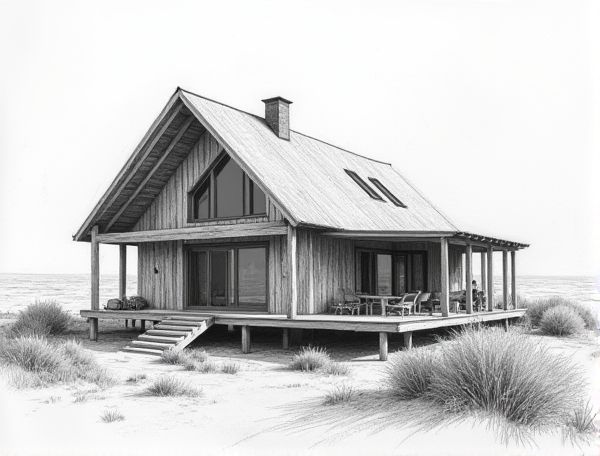
Photo illustration: Coastal home design with seaweed insulation
Seaweed insulation offers a sustainable and energy-efficient solution for coastal home design, providing excellent thermal performance while resisting moisture and salt air damage. Discover how incorporating seaweed insulation can enhance Your coastal home's comfort and eco-friendliness by reading more in the article.
Introduction to Coastal Home Design
Coastal home design emphasizes natural light, airy spaces, and the use of materials like driftwood, seashells, and soft blues to create a relaxing beach-inspired atmosphere. Your interior can seamlessly blend with the outdoors by incorporating large windows, open floor plans, and weather-resistant finishes.
The Rise of Sustainable Building Materials
Sustainable building materials like bamboo, recycled steel, and reclaimed wood are revolutionizing home design by reducing environmental impact and enhancing energy efficiency. Choosing these eco-friendly options supports your home's durability while promoting a healthier planet for future generations.
Why Seaweed Insulation?
Seaweed insulation offers exceptional thermal and acoustic properties, making your home energy-efficient and quieter while reducing environmental impact due to its sustainable and renewable nature. Choosing seaweed insulation enhances indoor air quality by naturally resisting mold, mildew, and pests, ensuring a healthier living space for you.
Benefits of Seaweed Insulation in Coastal Climates
Seaweed insulation provides exceptional thermal regulation and moisture resistance, making it ideal for coastal homes exposed to high humidity and salt air. Its natural antifungal and pest-repellent properties enhance indoor air quality and durability, reducing maintenance costs in marine environments.
How Seaweed Insulation Works
Seaweed insulation utilizes harvested seaweed fibers, which are naturally rich in cellulose and alginates, providing excellent thermal and acoustic properties. The fibers are processed into dense mats or panels that trap air, reducing heat transfer and improving energy efficiency in homes. This sustainable material also offers moisture regulation and resistance to mold, making it an eco-friendly alternative to conventional insulation.
Design Considerations for Coastal Homes
Coastal home design prioritizes materials resistant to saltwater corrosion and high humidity, such as treated wood and marine-grade stainless steel. Strategic elevation and reinforced foundations mitigate flood risks while maximizing views of the shoreline. Incorporating large windows and open floor plans enhances natural light and ventilation, creating a seamless indoor-outdoor living experience.
Integrating Seaweed Insulation into Architectural Plans
Incorporating seaweed insulation into your architectural plans enhances energy efficiency while promoting sustainability through a renewable, biodegradable material. Seaweed's natural thermal and moisture-regulating properties improve indoor air quality and reduce reliance on synthetic insulators. Optimizing your design with this eco-friendly solution supports eco-conscious construction and contributes to long-term cost savings in heating and cooling.
Case Studies: Successful Coastal Homes with Seaweed Insulation
Case studies of successful coastal homes using seaweed insulation reveal remarkable improvements in thermal efficiency and moisture resistance, crucial for harsh seaside environments. Your home benefits from this sustainable material's natural ability to regulate humidity and reduce energy costs, ensuring comfort and durability against salty air and strong winds.
Eco-Friendly Maintenance and Longevity
Eco-friendly home maintenance utilizes sustainable materials such as bamboo flooring, low-VOC paints, and recycled steel, enhancing indoor air quality and reducing environmental impact. Implementing energy-efficient systems like solar panels, rainwater harvesting, and LED lighting extends the home's lifespan while lowering utility costs. Regular upkeep using non-toxic cleaning products and biodegradable sealants preserves structural integrity and promotes long-term durability.
Future Trends in Coastal Home Sustainability
Innovations in coastal home sustainability focus on integrating advanced materials like marine-grade composites and solar-reflective roofing to combat harsh saltwater environments and reduce energy consumption. Smart water management systems, including rainwater harvesting and greywater recycling, address rising concerns of water scarcity and flood resilience in coastal areas. Emphasis on net-zero energy designs and resilient landscaping further enhances the durability and environmental harmony of future coastal homes.
 homedesy.com
homedesy.com